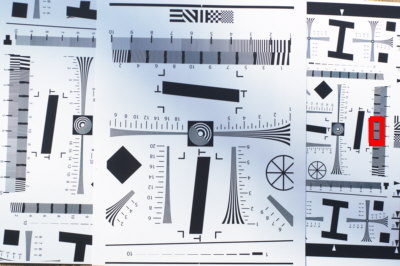

RAWHide’s Demosaicing Routines:
Bayer Pattern Demosaicing is one of the most crucial part of converting raw image data into a high quality aesthetically pleasing output image. Bayer Patterns (Raw Files) contain only 1/3 of the information of the “original” image or scene so the remaining 2/3’s of the information must be interpolated from the available data. This is no simple task as these examples show...
 |  |
| This reveals an image as your camera records it. The Red, Green, & Blue "Bayer" pattern. Each Pixel only records one of the three colors required for a true RGB image. | Here we have the "20" after conversion. This example shows one of the simplest examples one could think of, a simple "black-n-white" test target |
NO single routine (not even RAWHide's) can perfectly interpolate this data every time. All Routines have trade-offs. To address this, three advanced Demosaicing Routines were developed specifically for RAWHide to better cover the broad spectrum of images and subjects in your photographs. See the descriptions of RAWHide's available routines below.
Detail Accuracy:
Two of the Demosaicing Routines offered by RAWHide (ACC & AHD) are compared to the output of the best competitors. The crops shown are actual output from the same MRW raw file in which the test pattern photographed is at or very near the Nyquist Limit. RAWHide's ACC routine offers a series of manual adjustments that can help overcome a great number of the artifacts that befall others.
 |
|
RED area repeated below |
100%
|
|
|
|
|
|
|
|
| ACC | AHD | ACR | JPE | RSE | RM | SP |
300% Enlargements
 |
 |
 |
 |
 |
 |
 |
| RAWHide's ACC | AHD | Adobe ACR | In Camera Jpeg | RawShooter | RawMagick | SlikyPix |
RAWHide’s Included Demosaicing Routines:
ACC Demosaicing:
Advanced Chroma Corrective Demosaicing. This may be the one of most accurate and advanced routines available. This routine extracts the highest resolution and most detail with the lowest instance of moiré and color artifacts. Where the routines used in other programs fail, ACC excels. Trade-Offs: Best resolution and color artifact resistance vs. Lower point data accuracy then EWC and less natural grain in images with high ISO and extreme white balance. Red's can be "noisy".
ECW Demosaicing:
Expanding Chroma Weighted Demosaicing. Creates images with very natural film like characteristics and “grain”. Gives the best results when small point like detail approaches the maximum resolution of the sensor. Trade-Offs: Best point resolution and very natural image grain vs. increased “zipper” and color artifacts.
SNS Demosaicing:
Smooth and Slow Demosaicing. Ideally suited for portraits and skin. While this routine naturally combats noise, it should be noted that NO noise reduction employed. Perfect for cases where smooth natural results are needed and images can tolerate a higher degree of color artifacts. Trade-Offs: Smooth results vs. lower perceived resolution, increased color artifacts, and speed.
AHD Demosaicing:
Adaptive Homogeneity-Directed demosaicing algorithm by H. Keigo and T. Park in Cornell University. This routine is often considered to be the industry de facto standard. It appears this is the same routine used in Adobe Camera RawTM (at least version 3.2) and a number of others.
Fast Demosaicing:
The name says it all. This routine is meant to be fast. This routine will often give fine results it the output will be size reduced in such cases as web output or smaller prints, however, if the results are intended to be used for critical work or enlargements you will likely be happier with one of the other routines.
© 2007-2008 Franklin A. Holub - All Rights Reserved
Last Updated: 01/08/08 09:14 PM